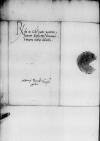Reddidit nobis generosus ⌊Achatius Czema⌋ castellanus Gdanensis ⌊⌋ Paternitatis Vestrae, quibus nos Paternitas Vestra in praesenti luctu ac maerore nostro, in quo nunc ex morte serenissimi generi nostri, domini ⌊Ioannis regis Hungariae⌋, constitutae sumus, graviter simul atque prudenter consolando medicinam dolori nostro adhibet. Id quod Paternitatem Vestram ex optimo suo atque sincero erga nos animo facere perspicimus.
Pro quo tam fideli ac humano officio Vestrae Paternitati meritas agimus atque habemus gratias.
Quin etiam haec propensio et studium Vestrae Paternitatis, quod ad inserviendum nostris et serenissimae dominae ⌊Hungariae reginae⌋ rebus Vestra Paternitas tam liberaliter offert, supra, quam dici potest, est nobis gratum. Et nisi incommoda valetudo Vestram Paternitatem impendivisset, nos illius servitio operaque consueta usi fuissemus, quam magno adiumento ad usum rerum modernarum accomodatam esse intelligimus propter ea, quod Paternitas Vestra magnum iam usum et cognitionem aulae ac morum cum aliorum principum, tum praecipue serenissimi ⌊regis Romanorum⌋ perfectissime tenet.
Verum, quoniam aliter, atque nos cupiebamus, evenit, sitque non minor occasio ac materia relicta, in qua Paternitas Vestra officium studiumque suum in inserviendo rebus ac negotiis sacrarum ⌊regiarum maiestatum⌋ in ⌊ista Prussiae provincia⌋ probare grataque efficere illarum maiestatibus ac nobis etiam potest, hortamur illam, ut pro officio debitoque suo senatorio Vestra Paternitas sicut bonus ac fidelis consiliarius suarum maiestatum ea istic gerat, agat, consulat, quibus amplissimam sibi suarum maiestatum ac etiam nostram gratiam comparare queat. Quandoquidem illarum ⌊maiestates⌋ et nos una  BCz, 1601, p. 674 non possumus, nisi bene velle iis, quos cernimus sacris eorum maiestatibus fideliter et magno cum animi sui studio inservire.
BCz, 1601, p. 674 non possumus, nisi bene velle iis, quos cernimus sacris eorum maiestatibus fideliter et magno cum animi sui studio inservire.
Singulariter vero commendamus Vestrae Paternitati negotium ⌊Marienburgensium⌋ et magnifici ⌊palatinidis Pomeraniae⌋, ut horum causam aequitatis plenam Vestra Paternitas suo etiam favore ac patrocinio tutandam promovendamque suscipiat, et eo magis, quod, uti Paternitas Vestra videt, ⌊Marienburgum⌋ est primum et praecipuum in ista provincia clenodium. Cuius loci cives aliique aliarum civitatum minorum ⌊Prussiae⌋ incolae non sunt etiam reiciendi, quandoquidem hi omnes aeque sunt cives ac membra unius corporis quam alii omnes quicumque; quorum etiam rationibus ac facultatibus prospici aequum est. Etenim Paternitas Vestra, ut iuratus ac prudens consiliarius ex aequo omnium commodis pro suo debito consulere debet.
In quam quidem rem, cum Paternitatem Vestram incumbere diligenter viderimus, tum demum illam fideliter ac utiliter et ⌊regiis maiestatibus⌋, et omnibus in universum ⌊Prussiae⌋ civitatibus et incolis inservire arbitrabimur. Quod pro fide debitoque suo et causa huius commendationis nostrae Vestra Paternitas ut faciat, illam etiam atque etiam cohortamur ac monemus. Eamque bene et feliciter valere optamus
 BCz, 1601, p. 674 non possumus, nisi bene velle iis, quos cernimus sacris eorum maiestatibus fideliter et magno cum animi sui studio inservire.
BCz, 1601, p. 674 non possumus, nisi bene velle iis, quos cernimus sacris eorum maiestatibus fideliter et magno cum animi sui studio inservire.


